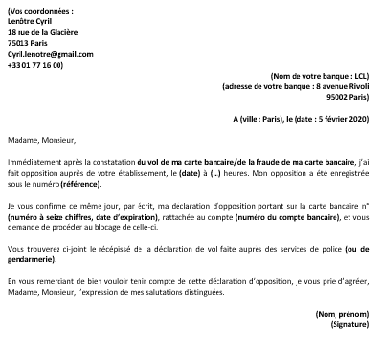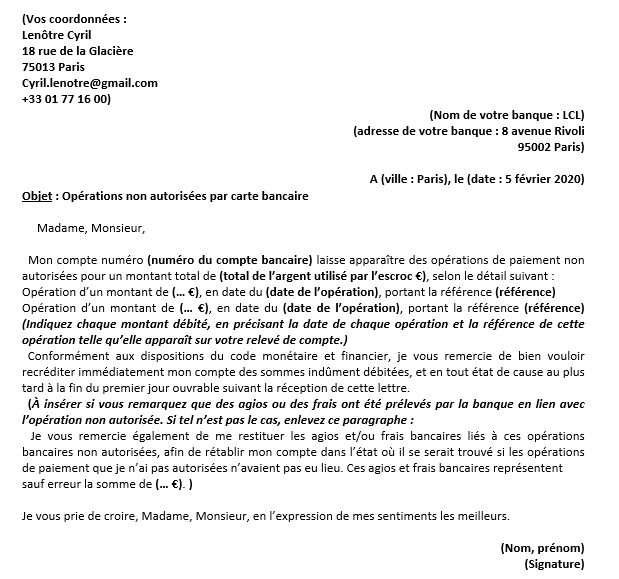Credit card theft
Lost, stolen bank card or fraud: stop payment[1]
– If I have lost my bank card or chequebook…
– If my wallet is stolen with my bank card or chequebook…
– Or if, when consulting my account statements (= document summarising withdrawals and additions of money to a bank account), I notice an abnormal, suspicious payment…
1 - I'll block my bank card right away! [1]
1) Call your bank or the interbank number 0 892 705 705. This number is not free and is available 24 hours a day, seven days a week (every day, at any time).
2) Write down the date and time of the call and the registration/opposition number you will be given.
3) Complete this card cancellation letter (the parts in bold and in brackets), addressed to your bank:

You must act very quickly.
If you stop payment too late, your bank may refuse to refund you. No transaction can be refunded if it is more than 13 months old.
Moreover, before the card is cancelled, you will have to bear the losses linked to the use of the card up to a limit of 150 euros (article L133-19 of the Monetary and Financial Code). So hurry up!
It will also refuse to reimburse you if it considers that you were negligent (for example, if your bank card code was visible to everyone). [1] 2 – I report the fraud on the Perceval website, which can be accessed from
https://www.service-public.fr/particuliers/vosdroits/R46526
1) Before logging on to the site, prepare the following documents
– your registration/opposition number, given by your bank or by the interbank number when you phoned.
– your bank card number
– your bank statements (= statements of account, summaries of withdrawals and additions of money to a bank account)
2) Log on to France-Connect. You can also use another account below (ameli.fr, impots.gouv)
3) You will be asked for information about purchases made without your permission by the fraudster/thief
4) The national gendarmerie will process your request.
5) You will receive an e-mail within a few hours.
6) Go to your personal Service-public space (log in to your Service-public account)
7) In the “My documents” section, you will find a receipt (= receipt, written document confirming that you have received a letter or parcel). Download the receipt. I print it out.
3 – I file a complaint with the police (= the police, the gendarmerie)
4 – I send the letter of confirmation of opposition to my bank
1) I print and sign the letter.
2) I collect :
– the receipt that I downloaded from the Service-public website.
– the receipt of the complaint.
3) I go to the Post Office and send the 3 documents by post, by recorded delivery with acknowledgement of receipt.
5 – I write a letter to my bank to ask for a refund[1]
1) Here is a model letter written by the Legal Information Service of UFC-Que Choisir. The aim is not to replace the advice that can be given to you by local associations that can help you or by legal professionals (a lawyer, a jurist…). It is an example to help you.

6 - What to do if the bank disagrees about the refund?
a) In the event of a dispute over a refund, you can refer the matter to the banking mediator.
b) If the intervention of the bank mediator does not put an end to the dispute, you can go to court.
The competent court depends on the sums involved in the dispute:
– For a dispute of €10,000 or less, it is the local court or the judicial court.
Where to go? The local court or the judicial court For a dispute over €10,000, it is the judicial court.
Tips for avoiding internet fraud
– Check your accounts often and contact your bank if there are any discrepancies.
– Update your anti-virus software.
– Never use a public computer or free wi-fi to make an online purchase or to check your bank account.
– When you receive a strange e-mail, check the e-mail address.
– Always log out of your account when checking your bank account on the internet.
– When you make a purchase online, or a transaction requiring payment, check the address of the site, and make sure the site is secure (green padlock):

[1] https://www.service-public.fr/particuliers/vosdroits/F20523
[2] https://www.quechoisir.org/lettre-type-fraude-a-la-carte-bancaire-demande-de-remboursement-n70307/
[3] https://www.challenges.fr/vie-pratique/litiges-conso/arnaque-a-la-carte-bancaire-comment-se-faire-rembourser_518880
[4] https://www.inc-conso.fr/content/banque/votre-carte-bancaire-disparu-vous-faites-opposition-aupres-de-votre-banque
[5] https://www.service-public.fr/particuliers/vosdroits/F31324
